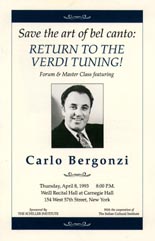
Highlights | Calendar | Music | Books | Concerts | Links | Education | Health
What's New | LaRouche | Spanish Pages | Poetry | Maps
Dialogue of Cultures
RETURN TO THE
VERDI TUNING!
Forum & Master Class Featuring
Carlo Bergonzi

Table of Contents
Concert Program
About the Program
Musical Examples:
Celeste Aida at C=256
Celeste Aida at A=440
Photos:
Piero Cappuccilli
Introduction by Sra. Rita Patané
and Kathy Wolfe (Schiller Institute)
Greetings from Maestro Carlo Bergonzi, and coaching of:
"Der Hölle Rache" (W.A. Mozart)
Darlene Bennett Johnson, coloratura soprano
"Se pieté di me non senti" (G.F. Handel)
Thia Carla Moore, lyric coloratura
"Tu che le vanitá" (G. Verdi)
Andrea Cawelti, lirico spinto soprano
"Una voce poco fa" (G. Rossini) Suzanne Loerch, mezzosoprano "0 don fatale" (G. Verdi) Alexandra Zalska, mezzosoprano
Intermission
"Cruda sorte!" (G. Rossini)
Ann Plagianos, mezzosoprano
"Una furtiva lagrima" (G. Donizetti)
John Sigerson, leggero tenor
"Celeste Aida" (G. Verdi)
Steven Tillman, lirico spinto tenor
"Il balen del suo sorriso" (G. Verdi)
Russell Saint John, baritone
"Aprite un po' quegl' occhi" (W.A. Mozart)
Arizeder Urreiztieta, bass
Glenn Morton is the accompanist for all selections.
Excerpts from each aria will be demonstrated first at the scientific "Verdi pitch" of C-256 (A-432) on the piano at your right, then at today's artificial "New York" pitch of A-442, on the piano at left. Sr. Bergonzi Will then work with the arias further at the Verdi tuning.
The kind assistance of the vocal instructors, Sra. Rita Patane, Ms. Betty Allen (Harlem School of the Arts), Ms. Virginia Lindle, Ms. Elaine Bonazzi (SUNY Stony Brook) and Ms. Mignon Dunn (Manhattan School of Music) is acknowledged, with deep gratitude.
Five years ago, on April 9, 1988 at the Schiller Institute's conference "Music and Classical Aesthetics" at the Casa Verdi in Milan, Italy, an international campaign was launched to restore the original pitch used by all Classical composers from Bach through Verdi. This lower tuning, at middle C=256 Hz, is grounded in the very physical laws of the universe.
The campaign was originally inspired by Lyndon H. LaRouche, Jr., whose collaborators uncovered the historical evidence that Giuseppe Verdi, Italy's greatest composer and nation-builder, had in 1884 demanded a ceiling for pitch at a diapason of A-432, based upon C-256, and won such a decree from the Italian government.
 |
||||
| Milan, Italy, April 1988. Baritone Piero Cappuccilli sings Verdi's “Il balen” from "Il Trovatore" at C-256 for the Schiller Institute conference "Music and Classical Aesthetics" at Casa Verdi | ||||
We also celebrate publication of the ground-breaking book A Manual on Tuning and Registration by the Schiller Institute which, after five years of research, gives the musical proof for the theory advanced at Milan.With the music itself of Mozart, Verdi, and other masters, Vol. 1, The Singing Voice, documents that all classical vocal music must be performed at C-256. Vol.2, Instrumental Voices, will give the proof for instrumental music.
Tonight, the era's leading bel canto tenor, Sr. Carlo Bergonzi, presents a host of these "Milan demonstrations," from the highest soprano to the bass, sung by New York vocal students. Sr. Bergonzi, now director of the Bel Canto Academy in Parma, uses student demonstrations to underline his concern, that rising modern pitch destroys the development of the young bel canto voice itself.
Lowering the pitch may be expensive and seem unpragmatic, but it is not, morally, debatable. Just as we must find a cure for AIDS, we must return to the tuning the voice requires, or face the extinction of great music.
Musical Examples


schiller@schillerinstitute.org
The Schiller Institute
PO BOX 20244
Washington, DC 20041-0244
703-297-8368
Thank you for supporting the Schiller Institute. Your membership and contributions enable us to publish FIDELIO Magazine, and to sponsor concerts, conferences, and other activities which represent critical interventions into the policy making and cultural life of the nation and the world.
Contributions and memberships are not tax-deductible.
VISIT THESE OTHER PAGES:
Home | Search | About | Fidelio | Economy | Strategy | Justice | Conferences | Join
Highlights | Calendar | Music | Books | Concerts | Links | Education | Health
What's New | LaRouche | Spanish Pages | Poetry | Maps
Dialogue of Cultures